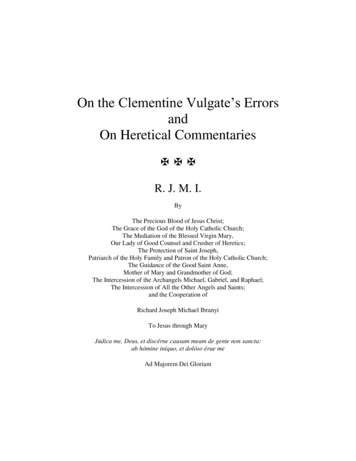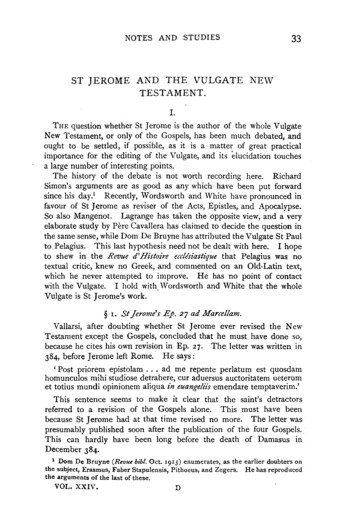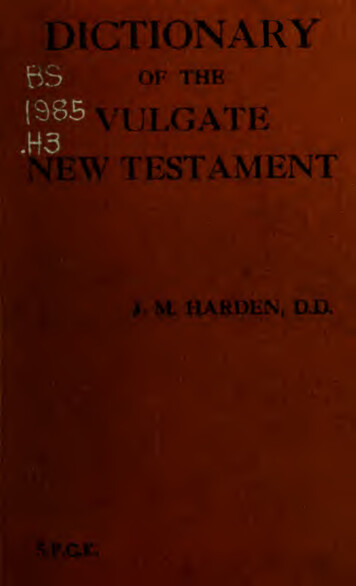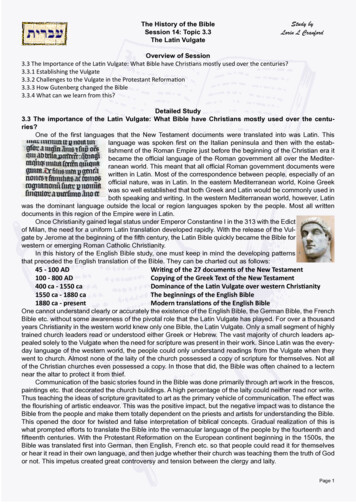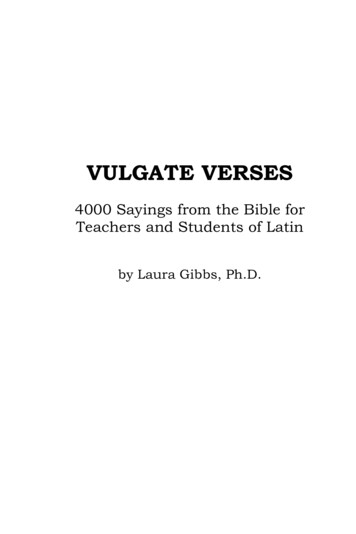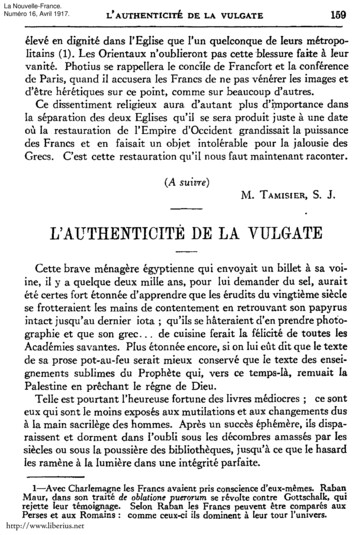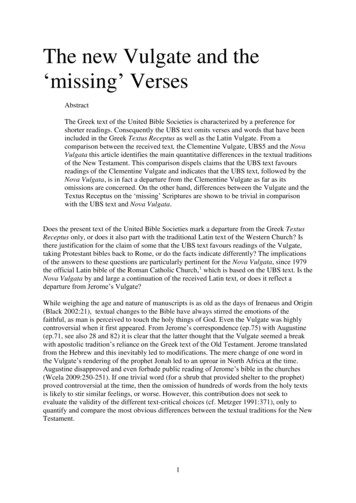
Transcription
The new Vulgate and the‘missing’ VersesAbstractThe Greek text of the United Bible Societies is characterized by a preference forshorter readings. Consequently the UBS text omits verses and words that have beenincluded in the Greek Textus Receptus as well as the Latin Vulgate. From acomparison between the received text, the Clementine Vulgate, UBS5 and the NovaVulgata this article identifies the main quantitative differences in the textual traditionsof the New Testament. This comparison dispels claims that the UBS text favoursreadings of the Clementine Vulgate and indicates that the UBS text, followed by theNova Vulgata, is in fact a departure from the Clementine Vulgate as far as itsomissions are concerned. On the other hand, differences between the Vulgate and theTextus Receptus on the ‘missing’ Scriptures are shown to be trivial in comparisonwith the UBS text and Nova Vulgata.Does the present text of the United Bible Societies mark a departure from the Greek TextusReceptus only, or does it also part with the traditional Latin text of the Western Church? Isthere justification for the claim of some that the UBS text favours readings of the Vulgate,taking Protestant bibles back to Rome, or do the facts indicate differently? The implicationsof the answers to these questions are particularly pertinent for the Nova Vulgata, since 1979the official Latin bible of the Roman Catholic Church,1 which is based on the UBS text. Is theNova Vulgata by and large a continuation of the received Latin text, or does it reflect adeparture from Jerome’s Vulgate?While weighing the age and nature of manuscripts is as old as the days of Irenaeus and Origin(Black 2002:21), textual changes to the Bible have always stirred the emotions of thefaithful, as man is perceived to touch the holy things of God. Even the Vulgate was highlycontroversial when it first appeared. From Jerome’s correspondence (ep.75) with Augustine(ep.71, see also 28 and 82) it is clear that the latter thought that the Vulgate seemed a breakwith apostolic tradition’s reliance on the Greek text of the Old Testament. Jerome translatedfrom the Hebrew and this inevitably led to modifications. The mere change of one word inthe Vulgate’s rendering of the prophet Jonah led to an uproar in North Africa at the time.Augustine disapproved and even forbade public reading of Jerome’s bible in the churches(Wcela 2009:250-251). If one trivial word (for a shrub that provided shelter to the prophet)proved controversial at the time, then the omission of hundreds of words from the holy textsis likely to stir similar feelings, or worse. However, this contribution does not seek toevaluate the validity of the different text-critical choices (cf. Metzger 1991:371), only toquantify and compare the most obvious differences between the textual traditions for the NewTestament.1
Problem statement and methodologyDuring the past century and a half, text-critical scholarship exchanged the traditional Greektext of the New Testament with a scholarly reconstruction of a possible original. This ismostly known as the Nestle-Aland or UBS text and sometimes referred to as the WestcottHort approach.2 As a result, the traditional Greek text of the Eastern Church, which was alsofollowed by the Church of the Reformation, was replaced as the “grundtext” for most modernBible translations. Metzger (1983:xxiii): “It was the corrupt Byzantine form of text thatprovided the basis for almost all translations of the New Testament into modern languagesdown to the nineteenth century.”Unlike the Byzantine form, the UBS text is not based on a single manuscript or textualtradition. Instead, the UBS text was decided on verse by verse by a committee of scholars,who considered a wide range of textual traditions and variants. As such the UBS text is anamalgamation of text-critical choices with the overall aim to reconstruct the ‘original’ text.Generally much weight is assigned in these considerations to some manuscripts, sometimesreferred to as “Alexandrian” text, which main feature is that it is shorter than the traditionalChurch text. To assess the differences and influence of textual traditions it is therefore helpfulto focus on the most significant of these ‘omissions,’ or ‘additions,’ depending on the textualperspective. It should also be noted that from a USB point of view omissions are not anegative assault on the text, but serve to strengthen confidence in authenticity: “Linguisticanalysis of texts soon shows that tantalizing omissions are one of the principal marks ofgenuineness.” (Nida 1972:79)This article seeks to identify those passages in the New Testament which have undergoneprofound changes as a consequence of text-critical choices. It makes an inventory of the“missing Scriptures”, verses and passages that used to be in church bibles, but have beendeleted in most contemporary versions. In other words, it lists the ‘missing’ verses, but alsoother verses that have been significantly affected by text-critical omissions.While the difference between the prevailing text-critical approach and the traditional Greektext is widely acknowledged, what is the situation for the Latin text of the New Testament?3The focus of this contribution is on the Nova Vulgata of the Roman Catholic Church (basedon Nestle-Aland/UBS).4 This new Latin standard bible has proved controversial, particularlysince the Congregation for Divine Worship and the Discipline of the Sacraments issued aninstruction (Liturgiam Authenticam, 2.1.24, May 7, 2001) that seemed to make its translationprinciples compulsory for Catholic Biblical scholarship. Some decided on a differentinterpretation (Clifford 2001:197-202), while others continued to be upset because the primefacie value of the text as such. Liturgiam Authenticam was experienced as far too traditional,and the Nova Vulgata insufficiently in line with critical translation principles. Perhaps themost devastating criticism came from the secretary of the Catholic Biblical Association ofAmerica: “Those who teach Scripture would not use a Bible dependent on the poor textcritical principles proposed by Liturgiam Authenticam” (Jensen 2001).As far as the Old Testament is concerned, major differences between Jerome’s text and theNova Vulgata have been pointed out already, e.g. a comparison on the book of Daniel hasresulted in a very substantial list of differences of 12 pages! (Courtray 2008:114-126.) Whatis the situation for the New Testament? At the level of translation principles, there aredissimilarities. For instance, Jerome’s Latin in John’s Gospel often uses a future tense wherethe Greek uses a present tense to also reflect on the future. The Nova Vulgata follows “what2
text critics of Greek manuscript copies considered to be the accurate Greek-languagetransmission of the Gospels” (Boughton 2002:223, cf. Schmidt 1980:356). Also, there areapproximately 2000 differences that have been recognized between the Nova Vulgata and thecritical Stuttgart text of the Gospels (Houghton 2016:133), but this result is hard to qualify onan objective basis. Many of these differences seem very minor and might be rather due toslight differences in Latin word choice, syntax and word order rather than textual meaning.The number of differences as such is not a good measurement to distinguish between texts.Some variants are trivial, others may carry considerable weight. It is far more important toconsider those that have a huge impact on the text than those that don’t. Doing this in anobjective way is difficult. To diversify within the category of difference involves manyconsiderations, some of which are at a propositional level. A far more objective way to assessbasic textual dissimilarity is to look at quantitative differences between texts. In other words,one needs to assess what is present and what is missing in the comparison. The most practicalway to get to these differences for the New Testament is to compare the quantativedifferences between UBS and the received texts of the West and East. What are the mostobvious and significant omissions from the UBS text? Also, as to motivation, is there anyjustification for Protestant criticism that accuses text-critical scholarship of taking modernBible translations back to the Vulgate?5 Do all changes lead to Rome or might they overallreflect a departure from both the established Greek and the Latin textual traditions, whichprevailed in the East and West since the days of the ecumenical councils until the 20thcentury?This article will seek answers by comparing the Textus Receptus, the Clementine Vulgate,6the UBS5 text and the Nova Vulgata on the most significant quantitative differences betweenUBS and the received text: the ‘missing’ verses and other significant omissions.7 As unit ofmeasurement the Greek word count of the omissions is used as objective basis. For the Latinno word count is applied, as meaning prevails over word count in translations. The mainconsideration would be how many Greek words are reflected in the Latin (cf. Nida 1969:489490). This comparison does not claim to be exhaustive, but it does cover the most importantomissions from the UBS text in comparison with the Textus Receptus.8The Greek text of the Textus Receptus (TR) used here is the 1550 ‘royal’ edition by RobertStephanus. This allows historical comparison between ‘Rome’ and ‘Reformation,’ becausethe Sixtine Vulgate that many prefer to forget9 and its successor the Clementine Vulgate (V)were published in the 16th century. Orthodoxy is included at the same time, while the 1550‘royal’edition also basically agrees with the liturgical text of the Greek Churches, especiallyin Scrivener’s later reconstruction. The Clementine Vulgate, first published in 1592,represents the authoritative Vulgate tradition.10 For this research the 2006 edition BibliaSacra juxta Vulgatam Clementinam (approved by the Bishops’ Conference of England andWales, 9th January 2006) is used. The latest UBS text (UBS5, German Bible Society 2017)represents the present consensus amongst scholarship. Finally, the Nova Vulgata (NV) text isfrom the critical edition by Nestle-Aland, 28th edition (1985), which contains the 1979 LatinUBS text and reflects the historical basis for the Nova Vulgata.The following research questions are pertinent:1) -What are the most significant omissions (verses and words) from the Greek UBS text incomparison with the received text?2) -What is the Clementine Vulgate’s position on these omissions? Do these omissions reveala UBS tendency to favour readings of the Latin Vulgate?3
3) -What are the implications of these omissions for the Nova Vulgata, does it reflectcontinuity or discontinuity with the Latin Vulgate?There are three distinct categories of omissions: special status verses, ‘missing’ verses andsignificant omissions from present verses. All of these concern Bible passages that have beenfound lacking in authenticity by later text reconstructions.Category 1: special status versesThis first category consists of verses that were omitted in previous reconstructions or whichauthenticity continuous to be denied, while they are nonetheless present in the USB text. Inother words, while these verses are present they come with an indication that they are notconsidered a trustworthy part of the text. While they are not actually ‘missing,’ they aremarked as doubtful or not authentic.The least controversial of these passages are three verses in Matthew’s Gospel, which havebeen omitted in the past, but are now given the benefit of the doubt or are considered to bepart of the original text after all. They are not really a statistical factor for the purpose of thisarticle, but for the completeness of this overview they are still mentioned, as these verseshave been left out of some Greek editions and Bible translations. The Aland/UBS text usuallyindicates that these verses are or have been in doubt.Matt 9:3411TR: οἱ δὲ Φαρισαῖοι ἔλεγον Ἐν τῷ ἄρχοντι τῶν δαιμονίων ἐκβάλλει τὰ δαιμόνια. (12 words)V: Pharisæi autem dicebant: In principe dæmoniorum ejicit dæmones.UBS5: οἱ δὲ Φαρισαῖοι ἔλεγον, Ἐν τῷ ἄρχοντι τῶν δαιμονίων ἐκβάλλει τὰ δαιμόνια.NV: Pharisaei autem dicebant: In principe daemoniorum eicit daemones.Matt 12:4712TR: εἶπεν δέ τις αὐτῷ Ἰδού, ἡ μήτηρ σου καὶ οἱ ἀδελφοί σου ἔξω ἑστήκασιν ζητοῦντές σοιλαλῆσαι. (17 words)V: Dixit autem ei quidam: Ecce mater tua, et fratres tui foris stant quærentes te.UBS5: εἶπεν δέ τις αὐτῷ, Ἰδοὺ ἡ μήτηρ σου καὶ οἱ ἀδελφοί σου ἔξω ἑστήκασιν ζητοῦντές σοιλαλῆσαι.NV: Dixit autem ei quidam: Ecce mater tua et fratres tui foris stant quaerentes loqui tecum.Matt 21:44 13TR: Καὶ ὁ πεσὼν ἐπὶ τὸν λίθον τοῦτον συνθλασθήσεται· ἐφ' ὃν δ' ἂν πέσῃ λικμήσει αὐτόν.(15 words)V: Et qui ceciderit super lapidem istum, confringetur: super quem vero ceciderit, contereteum.UBS5: Καὶ ὁ πεσὼν ἐπὶ τὸν λίθον τοῦτον συνθλασθήσεται· ἐφ ὃν δ ἂν πέσῃ λικμήσειαὐτόν.NV: Et, qui ceciderit super lapidem istum confringetur; super quem vero ceciderit, contereteum.4
Although these verses are not omissions presently, for our research questions they are stilluseful as they confirm agreement between the Vulgate and the Textus Receptus as to theirinclusion and wording.More serious and with far greater quantitative consequences are two passages from Mark andJohn’s Gospel. While the authenticity of these passages is firmly denied by the UBScommittee responsible for the text, they continue to be included for other than text-criticalreasons.The first passage is the so called ‘longer’ ending of Mark’s Gospel. While the USB rejectsthis passage as not authentic, it is still, by and large, printed as part of the main text.14Mark 16:9-20TR: 9Ἀναστὰς δὲ πρωῒ πρώτῃ σαββάτου ἐφάνη πρῶτον Μαρίᾳ τῇ Μαγδαληνῇ ἀφ' ἡςἐκβεβλήκει ἑπτὰ δαιμόνια 10ἐκείνη πορευθεῖσα ἀπήγγειλεν τοῖς μετ' αὐτοῦ γενομένοιςπενθοῦσιν καὶ κλαίουσιν· 11κἀκεῖνοι ἀκούσαντες ὅτι ζῇ καὶ ἐθεάθη ὑπ' αὐτῆς ἠπίστησαν12Μετὰ δὲ ταῦτα δυσὶν ἐξ αὐτῶν περιπατοῦσιν ἐφανερώθη ἐν ἑτέρᾳ μορφῇ πορευομένοις εἰςἀγρόν· 13κἀκεῖνοι ἀπελθόντες ἀπήγγειλαν τοῖς λοιποῖς· οὐδὲ ἐκείνοις ἐπίστευσαν14Ὕστερον ἀνακειμένοις αὐτοῖς τοῖς ἕνδεκα ἐφανερώθη καὶ ὠνείδισεν τὴν ἀπιστίαν αὐτῶνκαὶ σκληροκαρδίαν ὅτι τοῖς θεασαμένοις αὐτὸν ἐγηγερμένον οὐκ ἐπίστευσαν 15καὶ εἶπεναὐτοῖς Πορευθέντες εἰς τὸν κόσμον ἅπαντα κηρύξατε τὸ εὐαγγέλιον πάσῃ τῇ κτίσει 16ὁπιστεύσας καὶ βαπτισθεὶς σωθήσεται ὁ δὲ ἀπιστήσας κατακριθήσεται 17σημεῖα δὲ τοῖςπιστεύσασιν ταῦτα παρακολουθήσει· ἐν τῷ ὀνόματί μου δαιμόνια ἐκβαλοῦσιν γλώσσαιςλαλήσουσιν καιναῖς 18ὄφεις ἀροῦσιν κἂν θανάσιμόν τι πίωσιν οὐ μὴ αὐτοὺς βλάψει, ἐπὶἀρρώστους χεῖρας ἐπιθήσουσιν καὶ καλῶς ἕξουσιν 19Ὁ μὲν οὖν κύριος μετὰ τὸ λαλῆσαιαὐτοῖς ἀνελήφθη εἰς τὸν οὐρανὸν καὶ ἐκάθισεν ἐκ δεξιῶν τοῦ θεοῦ 20ἐκεῖνοι δὲ ἐξελθόντεςἐκήρυξαν πανταχοῦ τοῦ κυρίου συνεργοῦντος καὶ τὸν λόγον βεβαιοῦντος διὰ τῶνἐπακολουθούντων σημείων. Ἀμήν. (166 words)V: Surgens autem mane prima sabbati, apparuit primo Mariæ Magdalene, de qua ejeceratseptem dæmonia. 10 Illa vadens nuntiavit his, qui cum eo fuerant, lugentibus et flentibus.11 Et illi audientes quia viveret, et visus esset ab ea, non crediderunt. 12 Post hæc autemduobus ex his ambulantibus ostensus est in alia effigie, euntibus in villam: 13 et illi euntesnuntiaverunt ceteris: nec illis crediderunt. 14 Novissime recumbentibus illis undecimapparuit: et exprobravit incredulitatem eorum et duritiam cordis: quia iis, qui viderant eumresurrexisse, non crediderunt. 15 Et dixit eis: Euntes in mundum universum prædicateEvangelium omni creaturæ. 16 Qui crediderit, et baptizatus fuerit, salvus erit: qui vero noncrediderit, condemnabitur. 17 Signa autem eos qui crediderint, hæc sequentur: in nomine meodæmonia ejicient: linguis loquentur novis: 18 serpentes tollent: et si mortiferum quid biberint,non eis nocebit: super ægros manus imponent, et bene habebunt. 19 Et Dominus quidemJesus postquam locutus est eis, assumptus est in cælum, et sedet a dextris Dei. 20 Illi autemprofecti prædicaverunt ubique, Domino cooperante, et sermonem confirmante, sequentibussignis.UBS5: included, but marked as later additions that are not part of the original text.NV: included.Review: Both the TR and the V include the ‘long ending’ of Mark 16:9-20 in an identicalway.15 UBS5 “out of deference to the evident antiquity of the longer ending and itsimportance in the textual tradition of the Gospel” (Metzger 1983:126) decided to print it,while denying its genuineness, followed by the NV.165
A similar case is the story of the adulterous woman in John 7:53-8:11. The UBS committeeacknowledged that it “was unanimous that the pericope was originally no part of the FourthGospel” (Metzger 1983:221) and it was marked as such, but a majority decided to print itanyway because of the “evident antiquity of the passage”. However, similar ‘evidentantiquity’ may be ascribed to many other significant passages that the committee decided toomit from the UBS text anyway. Thus, like the longer ending of Mark, this passage has aspecial status. Although it is technically not part of the ‘missing verses,’ neither is itconsidered part of the original.John 7:53-8:11TR: 53Καὶ ἐπορεύθη ἕκαστος εἰς τὸν οἶκον αὐτοῦ. 1Ἰησοῦς δὲ ἐπορεύθη εἰς τὸ Ὄρος τῶνἘλαιῶν 2Ὄρθρου δὲ πάλιν παρεγένετο εἰς τὸ ἱερόν καὶ πᾶς ὁ λαὸς ἤρχετο πρὸς αὐτόν καὶκαθίσας ἐδίδασκεν αὐτούς 3ἄγουσιν δὲ οἱ γραμματεῖς καὶ οἱ Φαρισαῖοι πρὸς αὐτὸν γυναῖκαἐν μοιχείᾳ κατειλημμένην καὶ στήσαντες αὐτὴν ἐν μέσῳ 4λέγουσιν αὐτῷ Διδάσκαλε αὕτη ἡγυνὴ κατείληφθη ἐπαυτοφώρῳ μοιχευομένη· 5ἐν δὲ τῷ νόμῳ Μωσῆς ἡμῖν ἐνετείλατο τὰςτοιαύτας λιθοβολεῖσθαι· σὺ οὖν τί λέγεις 6τοῦτο δὲ ἔλεγον πειράζοντες αὐτόν ἵνα ἔχωσινκατηγορεῖν αὐτοῦ ὁ δὲ Ἰησοῦς κάτω κύψας τῷ δακτύλῳ ἔγραφεν εἰς τὴν γῆν 7ὡς δὲἐπέμενον ἐρωτῶντες αὐτόν ἀνάκυψας εἶπεν πρὸς αὐτούς Ὁ ἀναμάρτητος ὑμῶν πρῶτος τὸνλίθον ἐπ' αὓτη βαλέτω 8καὶ πάλιν κάτω κύψας ἔγραφεν εἰς τὴν γῆν 9οἱ δὲ ἀκούσαντες καὶὑπὸ τῆς συνειδήσεως ἐλεγχόμενοι, ἐξήρχοντο εἷς καθ' εἷς ἀρξάμενοι ἀπὸ τῶν πρεσβυτέρωνἕως τῶν ἐσχάτων καὶ κατελείφθη μόνος ὁ Ἰησοῦς, καὶ ἡ γυνὴ ἐν μέσῳ ἑστῶσα 10ἀνακύψαςδὲ ὁ Ἰησοῦς καὶ μηδένα θεασάμενος πλὴν τὴς γυναικὸς, εἶπεν αὐτῇ Ἡ γυνή ποῦ εἰσιν ἐκεῖνοιοἱ κατήγοροί σου οὐδείς σε κατέκρινεν 11ἡ δὲ εἶπεν Οὐδείς κύριε εἶπεν δὲ αὐτῇ ὁ ἸησοῦςΟὐδὲ ἐγώ σε κατακρίνω· πορεύου καὶ μηκέτι ἁμάρτανε. (191 words)V: included.UBS5: included, but marked as a later addition that is not part of the original text.NV: included.Review: With some minor changes this pericope is provisionally included in UBS5 and theNova Vulgata, while the Clementine Vulgate includes this pericope similar to the TextusReceptus. As with the three verses in Matthew, this pericope confirms agreement betweenthe traditional Greek and Latin texts on its inclusion.Concerning these verses that are printed, but marked rejected in UBS, the overall conclusionis that the Clementine Vulgate and Textus Receptus agree on the wording and inclusion ofthese ‘special status’ passages in the sacred text. The Nova Vulgata and UBS text include thenumerically most substantial of these despite text critical conciderations; more for atraditional preference rather than strict scholarly reason. While the text-critical weight in theGreek manuscripts for the inclusion of the three verses from Matthew is reasonably strong bythe usual standards, applying these criteria to Mark 21:9-20 and John 7:53-8:11 should haveled to their exclusion. Because of their difference textual basis and preference neither theTextus Receptus nor the Clementine Vulgate shares this view. They are united in consideringthese passages, which UBS/NV do not consider authentic but print anyway, part of the sacredtext. Athough these verses are not actually omitted by UBS/NV, they constitute a principleddisagreement between the Clementine Vulgate and Textus Receptus on the one hand, andUBS5 and Nova Vulgata on the other. The results for this category ‘special status’ aresummarized graphically in the following way:6
Vulgate / Textus Receptus agreement on InclusionSpecial Status Verses (Greek Word Basis)Matt 9:34Matt 12:47Matt 21:44Mark 16:9-20John 0Mark 16:9-20John 7:53-8:11TR/VVUBS5NVSpecial Status PassagesCategory 2: the ‘missing’ versesThe second category is more straightforward than the first one. These are complete versesthat have been omitted from the UBS text, because they are not considered part of theoriginal for text-critical reason. Unlike Mark 21:9-20 and John 7:53-8:11 (rejected but stillincluded), these verses of the second category are in fact no longer included in the UBS text.Consequently, they are sometimes referred to as the “missing verses”, as Bible translationsbased on the UBS text no longer carry these. Most of these verses concern the Gospels andthe book of Acts.Matt 17:21TR: τοῦτο δὲ τὸ γένος οὐκ ἐκπορεύεται εἰ μὴ ἐν προσευχῇ καὶ νηστείᾳ.V: (17:20) Hoc autem genus non ejicitur nisi per orationem et jejunium.UBS5: omitted.NV: omitted.177
Difference: Both the TR and the V include this verse in an identical way, while UBS5 andNV leave it out. (12 words)Matt 18:11TR: ἦλθεν γὰρ ὁ υἱὸς τοῦ ἀνθρώπου σῶσαι τὸ ἀπολωλός.V: Venit enim Filius hominis salvare quod perierat.UBS5: omitted.NV: omitted.Difference: Both the TR and the V include this verse in an identical way, while UBS5 andNV leave it out. (9 words)Matt 23:14TR: Οὐαὶ δέ ὑμῖν, γραμματεῖς καὶ Φαρισαῖοι ὑποκριταί, ὅτι κατεσθίετε τὰς οἰκίας τῶν χηρῶν,καὶ προφάσει μακρὰ προσευχόμενοι· διὰ τοῦτο λήψεσθε περισσότερον κρίμα.V: Væ vobis scribæ et pharisæi hypocritæ, quia comeditis domos viduarum,orationes longas orantes! propter hoc amplius accipietis judicium.UBS5: omitted.NV: omitted.Difference: Both the TR and the V include this verse in an identical way, while UBS5 andNV leave it out. (22 words)Mark 7:16TR: Εἴ τις ἔχει ὦτα ἀκούειν, ἀκουέτω.V: Si quis habet aures audiendi, audiat.UBS5: omitted.NV: omitted.Difference: Both the TR and the V include this verse in an identical way, while UBS5 andNV leave it out. (6words)Mark 9:44TR: ὅπου ὁ σκώληξ αὐτῶν οὐ τελευτᾷ, καὶ τὸ πῦρ οὐ σβέννυται.V: (9:43) ubi vermis eorum non moritur, et ignis non extinguitur.UBS5: omitted.NV: omitted.Difference: Both the TR and the V include this verse in an identical way, while UBS5 andNV leave it out. (11 words)Mark 9:46TR: ὅπου ὁ σκώληξ αὐτῶν οὐ τελευτᾷ, καὶ τὸ πῦρ οὐ σβέννυται.V: (9:47)18 ubi vermis eorum non moritur, et ignis non extinguitur.UBS5: omitted.NV: omitted.8
Difference: Both the TR and the V include this verse in an identical way, while UBS5 andNV leave it out. (11 words)Mark 11:26TR: εἰ δὲ ὑμεῖς οὖκ ἀφίετε, οὐδε ὁ πατὴρ ὑμῶν ὁ ἐν τοῖς οὐρανοῖς ἀφησεὶ τὰ παραπτώματαὑμῶνV: Quod si vos non dimiseritis: nec Pater vester, qui in cælis est, dimittet vobis peccatavestra.UBS5: omitted.NV: omitted.Difference: Both the TR and the V include this verse in an identical way, while UBS5 andNV leave it out. (17 words)Mark 15:28TR: καὶ ἐπληρώθη ἡ γραφὴ ἡ λέγουσα, Καὶ μετὰ ἀνόμων ἐλογίσθηV: Et impleta est Scriptura, quæ dicit: Et cum iniquis reputatus est.UBS5: omitted.NV: omitted.Difference: Both the TR and the V include this verse in an identical way, while UBS5 andNV leave it out. (10 words)Luke 17:36TR: omitted.19V: (part of 17:35, 37 divided up in 36 and 37) duo in agro: unus assumetur, et alterrelinquetur.UBS5: omitted.NV: omitted.20Difference: Although Stephen’s TR omits this verse, Scrivener and other editions join the Vin including this verse in an identical way, while UBS5 and NV leave it out. Metzger(1983:168) considers that this may have been omitted because of similar word endings(homoeoteleuton) but thinks it more probable that copyists assimilated the passage to Matt24:40. (12 words)Luke 23:17TR: ἀνάγκην δέ εἶχεν ἀπολύειν αὐτοῖς κατὰ ἑορτὴν ἕνα.V: 17 Necesse autem habebat dimittere eis per diem festum unum.UBS5: omitted.NV: omitted.Difference: Both the TR and the V include this verse in an identical way, while UBS5 andNV leave it out. (8 words)9
Joh 5:4TR: ἄγγελος γὰρ κατὰ καιρὸν κατέβαινεν ἐν τῇ κολυμβήθρᾳ, καὶ ἐτάρασσεν τὸ ὕδωρ· ὁ οὖνπρῶτος ἐμβὰς μετὰ τὴν ταραχὴν τοῦ ὕδατος, ὑγιὴς ἐγίνετο, ᾧ δήποτε κατειχετο νοσήματι.V: Angelus autem Domini descendebat secundum tempus in piscinam, et movebaturaqua. Et qui prior descendisset in piscinam post motionem aquæ, sanus fiebat a quacumquedetinebatur infirmitate.UBS5: omitted.NV: omitted.Difference: Both the TR and the V include this verse in an identical way,21 while UBS5 andNV leave it out. (27 words)Acts 8:37TR: εἶπεν δὲ ὁ Φίλιππος Εἰ πιστεύεις ἐξ ὅλης τὴς καρδίας, ἔξεστιν ἀποκριθεὶς δὲ εἶπενΠιστεύω τὸν ὑιὸν τοῦ Θεοῦ ἐιναι τὸν Ἰησοῦν Χριστόν.V: Dixit autem Philippus: Si credis ex toto corde, licet. Et respondens ait: Credo Filium Deiesse Jesum Christum.UBS5: omitted.NV: omitted.Difference: Both the TR and the V include this verse in an identical way, while UBS5 andNV leave it out. (23 words)Acts 15:34TR: ἔδοξεν δὲ τῷ Σίλᾳ ἐπιμεῖναι αὐτοῦ (Scrivener’s plus GOC1904:ἔδοξε δὲ τῷ Σίλᾳ ἐπιμεῖναι αὐτοῦ.)V: Visum est autem Silæ ibi remanere: Judas autem solus abiit Jerusalem.UBS5: omitted.NV: omitted.Difference: Both the TR and the V include this verse in a similar way, while UBS5 and NVleave it out. Whilst the V adds Judas autem solus abiit Jerusalem this is not included in TR,UBS5 or NV. (6 words)Acts 24:7TR: παρελθὼν δὲ Λυσίας ὁ χιλιαρχος μετὰ πολλῆς βίας ἐκ τῶν χειρῶν ἡμῶν ἀπήγαγενV: 7 Superveniens autem tribunus Lysias, cum vi magna eripuit eum de manibus nostrisUBS5: omitted.NV: omitted.Difference: Both the TR and the V include this verse in an identical way, while UBS5 andNV leave it out. (13 words)Acts 28:29TR: καὶ ταῦτα αὐτοῦ εἰπόντος, ἀπῆλθον οἱ Ἰουδαῖοι, πολλὴν ἔχοντες ἐν ἑαυτοῖς συζήτησινV: 29 Et cum hæc dixisset, exierunt ab eo Judæi, multam habentes inter se quæstionem.UBS5: omitted.NV: omitted.10
Difference: Both the TR and the V include this verse in an identical way, while UBS5 andNV leave it out. (12 words)Rom 16:24TR: Ἡ χάρις τοῦ Κυρίου ἡμῶν Ἰησοῦ Χριστοῦ μετὰ πάντων ὑμῶν ἀμήνV: 24 Gratia Domini nostri Jesu Christi cum omnibus vobis. Amen.UBS5: omitted.NV: omitted.Difference: Both the TR and the V include this verse in an identical way, while UBS5 andNV leave it out. (11 words)Because these ‘missing verses’ as a body (particularly in combination with Mark 21:9-20 andJohn 7:53-8:11) constitute the most important quantitative difference between UBS and thetraditional text of the New Testament, they offer a general indication and a basis forcomparison of the diverse textual traditions. As to research question one, 210 Greek wordshave been omitted from the UBS text. Combined with Mark 21:9-20 and John 7:53-8:11 (356words with omission status) that ads up to a total of 566 words lacking in authenticity. As toresearch question two, all these omissions show unequivocally that the Vulgate sides with theTextus Receptus on their inclusion and wording. These exclusions from the UBS text dispelany alleged favouritism as they are departures from the text of the Clementine Vulgate asmuch as they are from the Textus Receptus. As to research question three, the Nova Vulgatais shown to faithfully follow the UBS text and to depart as much from Jerome’s text as it doesfrom the Byzantine East. Or, stated in terms of Bible translation: New Testament bibles thatare based on the received text, like the King James Version are almost identical to theClementine Vulgate, whilst translations that are based on the UBS text, like the Nova Vulgata(and most contemporary Catholic Bible translations in other languages) are not.The results for the category ‘missing’ verses are summarized in the following table andcharts:Vulgate agreement for'missing' versesTextus ReceptusUBS5/Nova VulgataScrivener's TextusReceptus11
The 'missing' Verses (Greek Word Basis)TRMatt 17:21Matt 18:11Matt 23:14Mark 7:16Mark 9:44Mark 9:46Mark 11:26Mark 15:28Luke 17:36Luke 23:17Joh 5:4Acts 8:37Acts 15:34Acts 24:7Acts 28:29Rom R40V30UBS20NV100MatthewMarkLukeJohnActsRomansThe 'missing' Verses on Greek word BasisMatthewMarkLukeJohnActs1200000000000000000
Category 3: verses with significant omissionsTo test the conclusions from the previous sections more closely, apart from the ‘missing’verses, it is also helpful to consider verses with a substantial number of missing words (in thetext of the United Bible Societies). This category concerns instances where a verse, as such,is present, but some words that are traditionally found in the Textus Receptus and/or theVulgate are excluded by UBS/NV. Significant omissions should be read in terms of numberof words. This third category could have been expanded considerably, had not the number ofwords but theological signifance be the criterion. Then also single words and alterationswould have to be considered. However, this would have involved theological choices andendless possibilities for debate, losing sight of the purpose of this article. Althought he listprovided below does not pretent to be exhaustive, it presents a fair selection of verses thathave a number of words ‘missing,’ significant enough in terms statistical difference toestablish results in an unbiased way. So this final category serves as a further statisticalconfirmation or denial of the findings of the other categories. As already indicated in themethodology, this comparison is not a reflection on text-critical choices, but serves solely tobring out the differences and agreements. In this way this examination checks the preliminaryconclusions that emerged from the previous section on the ‘missing verses’.Matt 5:44TR: ἐγὼ δὲ λέγω ὑμῖν ἀγαπᾶτε τοὺς ἐχθροὺς ὑμῶν εὐλογειτε τοὺς καταρωμένους ὑμᾶς καλῶςποιεῖτε τοὺς μισοῦντας ὑμᾶς, καὶ προσεύχεσθε ὑπὲρ τῶν ἐπηρεαζόντων ὑμᾶς, καὶ διωκόντωνὑμᾶς,V: ego autem dico vobis diligite inimicos vestros benefacite his qui oderunt vos et orate propersequentibus et calumniantibus vos.UBS5: ἐγὼ δὲ λέγω ὑμῖν, ἀγαπᾶτε τοὺς ἐχθροὺς ὑμῶν καὶ π
the Sixtine Vulgate that many prefer to forget9 and its successor the Clementine Vulgate (V) were published in the 16th century. Orthodoxy is included at the same time, while the 1550 ‘royal’edition also basically agrees with the liturgical text of the Greek
